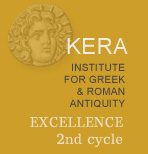Sofular
5 |
Μόλη<ς> Μ(άρκου) Ἰου– λίου δίς τοῦ Πυ– <θ>ᾷ τῷ ἀδελφῷ Ἑρμαίῳ μνήμης χάριν. |
Moles, son of Marcus Iulius II, great-grandson of Pythas, in memory of his brother Hermaios.
Round molded funerary base with relief depicting two raised hands, seen by Naour in 1974 in the village Sofular, 7 km NW of Boubon.
Height: at least 94 cm; diameter: 40 cm; letters: 3-4 cm.
Naour 1976, p. 122, no. 14 (pl. VII.14); SEG 26 (1976-77), 1430.
L. 1 : Instead of the sigma, the stone has two oblique lines resembling a lambda. On Μόλης see no. 63.
L. 3-4 : Πυθᾶς: omicron in place of the theta. On names in -ᾶς see Robert 1938, 153-154 and 182-192). On Ἑρμαῖος see no. 71.
The stone was in the courtyard of a mosque near the modern road from Çameli to the plain of Boubon in a region, as described by Naour, "towards the hill situated between Kömürlük dağ and Eren tepe" (also called Yaylacı tepe, or Yaylacık dağ). On our information, that hill is referred to by the ubiquitous name of Asar tepe (asar: ruins). In 2006, the stone was installed on top of the wall surrounding the yard of the mosque in the center of the village, together with four other funerary columns, in part inscribed and also featuring schematic depictions of raised hands. One of the stones bears such a schematic drawing, as well as four lines saying that the tomb was raised by Ναννα, daughter of Φιλέτας, for her son Φιλώτας. Naour reports a sarcophagus lid, pottery sherds and tiles in the village near the mosque, and funerary columns in the cemetery. There must have existed an ancient settlement with easy access to the plain of Boubon at or near the modern village (Naour, op. cit., p. 122). Further, Naour saw rectangular blocks and fragments of columns near a fountain at the village Arıkaya on the road leading to Boubon. At the old cemetery of Arıkaya there were numerous ancient fragments. The modern–day road between Sofular and Boubon appears to follow an important ancient route, and the territory of Boubon must therefore have extended towards the West to include the region south of Çameli (Naour, op. cit., p. 123).
On the motif of raised hands on funerary inscriptions, see most recently Marek 2000, pp. 137-146; cf. id. 2003, p. 129.

